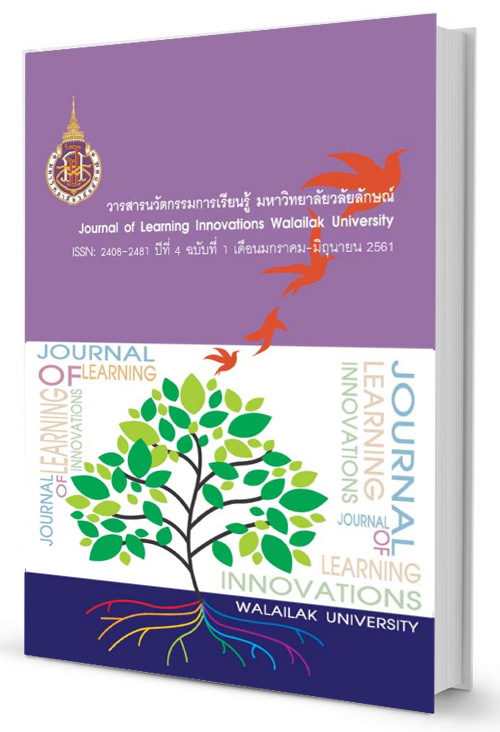A Study of The Experiences of Junior High School Students With Disipline Problems at a Prathum Thani School
DOI:
https://doi.org/10.14456/jli.2018.5Keywords:
Experiences in breaking school regulations, Indiscipline Issues, Barriers of learningAbstract
This qualitative study is aimed at identifying the factors that lead to indiscipline students who often break the school regulations to find out how such problems can be reduced and students who are at risk can be better taken care of so that they can concentrate on their studies. The data were collected from 7 students screened from two participant selection criteria: 1) They topped the school list of wrong doing and 2) their parents were invited to sign parole agreements with the school. There were 3 sets of instruments: 1) 30-minute individual semi-structured interviewing. The interviewed data were transcribed and analyzed with Grounded Theory and Constant Comparative Approach
2) Brief records of student behaviour while at school were kept for one semester and
3) Informal small talks with parents of the key informants were recorded. The contents of both 2 and 3 were content analyzed into categories for emerging patterns for interpretation.
The findings were ‘family’ and ‘friend’ were significant factors leading to student indiscipline. Observations of student behaviour revealed that students had problems with their temperament, unreasonably attraction to friends and inattention to study. The informal talks with parents indicated that grandparents excessively pampered their grandchildren resulting in the “Me-first” attitude and disobedience. Having no close supervision from parents, students turned to their friends and would do everything to win their hearts for their love and acceptance. When the results from 3 sets of data were compared for similarities and differences, it was found that major factors for students’ indiscipline were ‘family’, ‘friend’ and ‘temperament’.
Ways to solve this problem should take many forms that take place simultaneously as follows: Way 1: Prevention by the community, who will cooperate with one another
to take care of their children, Way 2: At school, students need to be given full attention by the teachers and Way 3: All stakeholders such as divorced parents, step parents, grandparents, and teachers should be intensively trained to understand their rolesin student support.
Recommendations for future research are 1) More research should be done in similar contexts such as in schools where there are lots of discipline problems to confirm that the factors found in this study are major causes of indiscipline 2) Use the findings of this study to design a model for an experimental research.
References
ตอนปลาย. (2559). ระเบียบวินัยของนักเรียน. กรุงเทพฯ: ผู้แต่ง.
จันทรเพ็ญ ชูประภาวรรณและคณะ (2541). รายงานการทบทวนองค์ความรู้เรื่อง เด็ก เยาวชน และครอบครัวในประเทศไทยและข้อเสนอแนะเชิงนโยบายและการวิจัย.สำนักงานสนับสนุนกองทุนวิจัย.มูลนิธิสาธารณะสุขแห่งชาติ.
ชาย โพธิสิตา. (2549). ศาสตร์และศิลป์แห่งการวิจัยเชิงคุณภาพ. นครปฐม: มหาวิทยาลัยมหิดล สถาบันวิจัยประชากรและสังคม.
ถวิล อรัญเวศ.(2560).การลงโทษนักเรียน/นักศึกษา. Thawin09.blogspot.com.
น้ำฝน กุลชุติธร. (2552). ปัญหาและแนวทางแก้ไขปัญหาการประพฤติผิดวินัยของนักเรียนโรงเรียนเทศบาล สังกัดเทศบาลเมืองชลบุรี. งานวิทยานิพนธ์ระดับบัณฑิตศึกษาของมหาวิทยาลัยบูรพา.
นราทิพย์ พุ่มทรัพย์.(2552).เปิดตัว 6 รร. ต้นแบบครอบครัวอบอุ่น.ผู้จัดการออนไลน์, 30 มิย. 2552.
ปรีตินัส จันทรากานตานันท์.(2556).ปัญหาและแนวทางการพัฒนาวินัยของนักเรียนโรงเรียนการุ้งวิทยาคม.การศึกษามหาบัณฑิต สาขาวิชาการบริหารการศึกษา มหาวิทยาลัยบูรพา.
โรงเรียนสามโคก. (2560) คู่มือนักเรียนและผู้ปกครอง ปีการศึกษา 2560. ปทุมธานี: ผู้แต่ง.
สำนักงานคณะกรรมการการศึกษาแห่งชาติ สำนักนายกรัฐมนตรี.พระราชบัญญัติการศึกษาแห่งชาติ พ.ศ. 2542 แก้ไขเพิ่มเติม (ฉบับที่ 2) พ.ศ. 2545. https://www.onec.go.th.
สำนักงานคณะกรรมการการศึกษาแห่งชาติ สำนักนายกรัฐมนตรี. แผนการศึกษาแห่งชาติ พ.ศ. 2560-2679.https://www.onec.go.th.
แพรวพรรณสุริยวงศ์. (2559). รู้ทันอารมณ์วัยรุ่น รับมือปัญหาความรุนแรง.สำนักงานกองทุนสนับสนุนการสร้างเสริมสุขภาพ 14 พฤศจิกายน 2559 เข้าถึงวันที่ 28 พฤษภาคม 2561at thaihealth.or.th.
วิศิษฏ์ อ้นขวัญเมือง. (2551). การปฏิบัติตามวินัยของนักเรียนช่วงชั้นที่ 3 โรงเรียนบ้านบ่อวิน สังกัดสำนักงานเขตพื้นที่การศึกษาชลบุรี เขต 3.งานวิทยานิพนธ์ระดับบัณฑิตศึกษาของมหาวิทยาลัยบูรพา.
สุรางค์ โค้วตระกูล. (2550).จิตวิทยาการศึกษา. สำนักพิมพ์แห่งจุฬาลงกรณ์มหาวิทยาลัย. อุทัย ดุลยเกษม.(2545). ศึกษาเรียนรู้ ภาค 2.มูลนิธิสดศรี สฤษดิ์วงศ์.
Ametepee, L.K., Chitiyo, M. and Abu, S. (2009). Examining the nature and perceived causes of indiscipline in Zimbabwean secondary schools. In British Journal of Special Education, Vol.36 No. 3.USA: Blackwell Publishing, pp. 155-160.
Bandura, A. (1977). Social foundations of thought and action: a social cognitive theory . Englewood Cliffs, NJ, USA: Prentice-Hall, Inc.
Canadian Mental Health Association. (2011). Children and self- esteem. Available at www. Cmha.ca/bins/content_page.asp?cid = 2-129-68.
Creswell, J. W. (2009). Research design-qualitative, quantitative, and mixed methods approaches. USA: SAGE Publications, Inc.
Creswell, J. W. and Poth, C. N. (2018). Qualitative Inquiry and Research Design: Choosing among Five Approaches, 4thed., Canada: Sage.
Darling-Hammond and Branford. (2005).Preparing teachers for a changing world: what teachers should learn and be able to do, pp.1-39.San Francisco, CA: Jossey-Bass.
Eisler, R. (2000). Tomorrow’s Children.USA: Westview Press.
Elbla, A.I. F. (2012). Is punishment (Corporal or Verbal) an effective means of discipline in schools? A case study of two basic schools in Greater Khartoum/Sudan. In Procedia-Social and Behavioural Sciences.Elsevier Ltd. Pp. 1656-1663
Erik Erikson (1902-1994) at www. Oaketon.edu 7 bfrank>Psy 120> Erikson’s Stages of Development.
Evertson, C. M. and Emmer, E. T. (1982). Effective management at the beginning of the school year in junior high school classes. In Journal of Educational Psychology, Vol.24 No.4, pp.485-498.
Frieman, B. (2001). What teachers need to know about children at risk. New York: McGraw Hill.
Fox, G. (2001). Supporting children with behaviour difficulties-a guide for assistants in schools, London: David Fulton Publishers.
McLeod, S.A.(2018).Sigmund Freud retrieved from www.simplypsychology.org/Sigmund Freud.html.
Maslow, A. (1987). Motivation and Personality. academia.edu.
Merriam , S. B. (1988). Case study research in education: A qualitative approach. USA: Jossey- Bass Publishers.
Minton, J. S. (2012). Using psychology in the classroom.London: SAGE Publications Ltd.
National Forum Education Administration and Supervision Journal. Volume, 32, No. 3, 2013.
Ormrod, J. E. (2003). Educational psychology-developing learners. New Jersey: Merrill prentice hall.
Rogus, J. F. (2001). Promoting self-discipline:a comprehensive Approach. Theory into practice. Vol. xxiv, No. 4, pp. 271-276.
Stake R. E. (1995). The art of case study research, Thousand Oaks, California, Sage Publications, Inc.
Stipek, D. (2002). Motivation to learn-Integrating theory and practice. Boston, Massachusetts: Allyn and Bacon.
Strauss, A. and Corbin, J. (1990).Basic of qualitative research-Grounded Theory–Procedures of developing Grounded Theory, Newbury Park, CA:SAGE.
Ugurlu, Beycioglu, Kondakei, Sincai, Yildirim, Ozer and oncel (2015). The views of Teachers towards perception of discipline in schools. In Procedia-Social and Behavioural Sciences.Elsevier Ltd. Pp. 120-125.
Vizard, D. (2007). How to manage behaviour in further education. London: Paul Chapman Publishing House.
Downloads
Published
How to Cite
Issue
Section
License
เนื้อหาและข้อมูลในบทความที่ลงตีพิมพ์ในวารสารนวัตกรรมการเรียนรู้ มหาวิทยาลัยวลัยลักษณ์ ถือเป็นข้อคิดเห็นและความรับผิดชอบของผู้เขียนบทความโดยตรง ซึ่งกองบรรณาธิการวารสาร ไม่จำเป็นต้องเห็นด้วย หรือร่วมรับผิดชอบใดๆ
บทความ ข้อมูล เนื้อหา รูปภาพ ฯลฯ ที่ได้รับการตีพิมพ์ในวารสารนวัตกรรมการเรียนรู้ มหาวิทยาลัยวลัยลักษณ์ ถือเป็นลิขสิทธิ์ของวารสารนวัตกรรมการเรียนรุ้ มหาวิทยาลัยวลัยลักษณ์ หากบุคคลหรือหน่วยงานใดต้องการนำทั้งหมดหรือส่วนหนึ่งส่วนใดไปเผยแพร่ต่อเพื่อกระทำการใดๆ จ้อต้องได้รับอนุญาตเป็นลายลักษณ์อักษรจากวารสารนวัตกรรมการเรียนรู้ มหาวิทยาลัยวลัยลักษณ์ก่อนเท่านั้น

